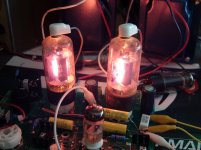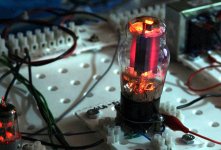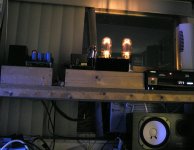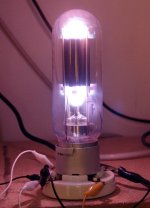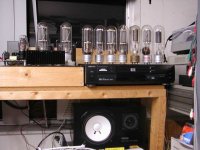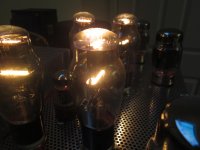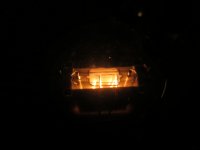Talking in Thorium, let me ask to the experts here how much per cent of thorium the Vintage NOS tubes had in the time of WW2 as 211,811,805,845 etc ??Thoriated Tungsten Filaments.
Gracias
You guys and your thirsty V8s, my car is a 73 Super Beetle
And my ride for the last 10 years has been a 2008 Honda Element with a 2.4L 4 cylinder. I have been thinking about getting something newer to replace it, but can't find anything that fits my current needs better than the "toaster."
So can read my newspaper
No need for a thoriated DHT.....just run a plain old TV sweep tube a wee bit over spec, or abuse a Chinese 6L6GC.
Although an 845 does have a much higher color temperature, better for reading......
But something's not quite right with this one....
Attachments
I built my 845 amp about 8 years ago. At the time (and even now) I could only afford cheap Chinese valves, so I ordered 4 so had 2 spare.
It's been in almost daily use since then and I'm still on the first pair with minimal re-biasing, even though it runs in A2.
True, I have run it in low power mode for much of the time PA 80W vs 100W but it's hard to hear the difference between the settings.
What can I say about it in defence of the OP? It sounds nice. It suffers from no blocking since it has no NFB. It has no detectable hum.
My wife, who is a music lover but not an audiophile, can hear a clear difference between it and a well built chip-amp.
It warms the house in winter. I had hoped to have a class D amp finished by now to run in summer - yes I'm sensitive our energy consumption's effect to climate change.
It's been in almost daily use since then and I'm still on the first pair with minimal re-biasing, even though it runs in A2.
True, I have run it in low power mode for much of the time PA 80W vs 100W but it's hard to hear the difference between the settings.
What can I say about it in defence of the OP? It sounds nice. It suffers from no blocking since it has no NFB. It has no detectable hum.
My wife, who is a music lover but not an audiophile, can hear a clear difference between it and a well built chip-amp.
It warms the house in winter. I had hoped to have a class D amp finished by now to run in summer - yes I'm sensitive our energy consumption's effect to climate change.
Audio is not only a "numbers" game. If numbers, or specifications, or "lowest distortion" was the driving force in audio we would only be using SS amps. Obviously, there are other elements in audio reproduction that can override a strictly technical analysis. You already embrace vacuum tubes which technically are inferior to SS devices so why do you doubt the legitimacy of high power vintage triodes? In the final analysis we all seek something that we subjectively relate to in a way that is deeper than a technical analysis. This means that as others have related sometimes what we pursue has less to do with objectivity than personal enjoyment. One of my teachers liked to remind us that " Not all knowledge resides in one house". Obviously, not my grammar teacher.Hello,
I’m trying to understand the point of an 845, 211, 805, etc. amplifier.
Are these amplifiers really more linear than say, a El34 ultra linear amp running in class A designed with, again, a quality circuit, parts, etc.? Is there something super special that I’m missing in an 845 SET amp (line magnetic, for example) that can’t be achieved in a 6p15 SET (Decware zen Torii, for example) plus a quality subwoofer?
Last edited:
To note the first post
It is not the same tubes. From the cpecs we can see that main factor for audio purposes is Ri - internal resistance of the tube. That will have huge impact for later designing the output transformer. And for a proper bandwidth offcourse
...
As the Ri is higher - as much Henrys in Primary windings it demands. For the solid low end. But next thing is that higher Lp [Hy] needs higher number of turns in primary. That will lead to increasing the capacitance, and will make issue for the opposite side of BW at highs. BUT main thing is the space to pack all turns, layers AND good isolation.
For these high Ri tubes like 211 type standard Transofmer laminations windows are just not enough. Increasing tha size of core to goal bigger space for copper layers will also increase lenght of turns, Rdc of copper wire, disturb the ratio of Magnetic lines [Lm]/gap, Lm will be longer so the gap shoud be longer too, BUT increasing tha gap we will losse Lp, induction of primary. Also Mass of Copper and mass of Iron will tend to Iron side, that will disturb the losses in Iron against tha losses in Copper... Also special techniques should be aplied for decreasing Ls, and Capacitances...
...
That is for the high Ri tubes, not so simple infact it is complicated and it is just opposite from that we can see, just one famous statements about OT "10K:8ohm"
...
The solution for OT for High Ri tubes could be to find nonstandard say EI lamination's, with larger window, same as the length of core middle "E". That is double space from standard. AND second vital thing is Permeability. Lamination's should have medium to higher relative permeability about 800. Not 250 to 400 like standard laminations. AND 0.35mm or smaller d. Without higher permability it is not posibile to acomplish huge inductance about 100Hy for the 211 for the example. In the other hand, Permeability simle should not be too high, because the core will go into DC current coming from Io of the output tube, into saturation more quickly... Again increasing the GAP we can decrease DC core saturation BUT we will loose the Primary inductance...
...
Sorry for the longer post.
From the specs, I think that 845 have the smaller Ri from other tubes in the list, and it is easier to mount OT for wider BW and smaller Phase shift at the edges of the BW.
...
Somebody can make comparative datas between Ri in typical working points for listed tubes?
It is not the same tubes. From the cpecs we can see that main factor for audio purposes is Ri - internal resistance of the tube. That will have huge impact for later designing the output transformer. And for a proper bandwidth offcourse
...
As the Ri is higher - as much Henrys in Primary windings it demands. For the solid low end. But next thing is that higher Lp [Hy] needs higher number of turns in primary. That will lead to increasing the capacitance, and will make issue for the opposite side of BW at highs. BUT main thing is the space to pack all turns, layers AND good isolation.
For these high Ri tubes like 211 type standard Transofmer laminations windows are just not enough. Increasing tha size of core to goal bigger space for copper layers will also increase lenght of turns, Rdc of copper wire, disturb the ratio of Magnetic lines [Lm]/gap, Lm will be longer so the gap shoud be longer too, BUT increasing tha gap we will losse Lp, induction of primary. Also Mass of Copper and mass of Iron will tend to Iron side, that will disturb the losses in Iron against tha losses in Copper... Also special techniques should be aplied for decreasing Ls, and Capacitances...
...
That is for the high Ri tubes, not so simple infact it is complicated and it is just opposite from that we can see, just one famous statements about OT "10K:8ohm"
...
The solution for OT for High Ri tubes could be to find nonstandard say EI lamination's, with larger window, same as the length of core middle "E". That is double space from standard. AND second vital thing is Permeability. Lamination's should have medium to higher relative permeability about 800. Not 250 to 400 like standard laminations. AND 0.35mm or smaller d. Without higher permability it is not posibile to acomplish huge inductance about 100Hy for the 211 for the example. In the other hand, Permeability simle should not be too high, because the core will go into DC current coming from Io of the output tube, into saturation more quickly... Again increasing the GAP we can decrease DC core saturation BUT we will loose the Primary inductance...
...
Sorry for the longer post.
From the specs, I think that 845 have the smaller Ri from other tubes in the list, and it is easier to mount OT for wider BW and smaller Phase shift at the edges of the BW.
...
Somebody can make comparative datas between Ri in typical working points for listed tubes?
Well samsdad I can give you the main point. They sound fantastic. Over the years I have built 4 or 5 different topologies from 6550, 300B, EL34 some in Ultralinear
PP some in single ended. I can confidently say my 845
SE wipes the floor with all of the proceeding designs based on other tubes in terms of sheer musical enjoyment. Just cap coupled all the way until the output iron. Is is more linear than the rest? The hell if I know as I have never bothered to measure - I just used my ears. (I also have all the bits to make a GM70 SE amp but have never managed to summon up the energy to get round to building another boat anchor. �� .
.
Whilst measurements are necessary to validate good basic operation of an amp at the end of the day it's more important that it sounds good to you - after all that's the whole point isn't it?
PP some in single ended. I can confidently say my 845
SE wipes the floor with all of the proceeding designs based on other tubes in terms of sheer musical enjoyment. Just cap coupled all the way until the output iron. Is is more linear than the rest? The hell if I know as I have never bothered to measure - I just used my ears. (I also have all the bits to make a GM70 SE amp but have never managed to summon up the energy to get round to building another boat anchor. ��
Whilst measurements are necessary to validate good basic operation of an amp at the end of the day it's more important that it sounds good to you - after all that's the whole point isn't it?
The point olf using triodes is, it is easy to copy a schematic of 1930'Th and get well sounding amplifier without the knowledge and experience of using feedbacks. The point of using transmitting triodes is possibility to drive wider range of speakers with sensitivity 90 dB / W / M or less.
Scobham,
Yes, BUT it can sound a much better. All You said + bonus, huge BW, deep clan natural base, highs with a "root" in the middle, Voices - real and beautifull. And that "Air" and "flow". A way better than ordinary SE OT designs...
...
I like 10Y SE design
(with good and not-easy-to-built OT. (ofcourse other things have to be coorect too, driving Dynamic capacitances, power supply extra care...)
Hi Waveburn
true, but it is only cloning of tube parts and sch as is. All other materials are different because these days is hard to find, and "standards" are changed... Power transformers then was better. Better calc and better lamination's and isolation. Even wires are not from the same quality. OT was a bit short, but only because a different BW standard. PiO Cs was also from smaller values. Theese days power Cs in the Amps are so huge?
...
Cheers
BTW I like mucho Your original approach, and many unique designs You presented here...
You presented here...
Yes, BUT it can sound a much better. All You said + bonus, huge BW, deep clan natural base, highs with a "root" in the middle, Voices - real and beautifull. And that "Air" and "flow". A way better than ordinary SE OT designs...
...
I like 10Y SE design
(with good and not-easy-to-built OT. (ofcourse other things have to be coorect too, driving Dynamic capacitances, power supply extra care...)
Hi Waveburn
true, but it is only cloning of tube parts and sch as is. All other materials are different because these days is hard to find, and "standards" are changed... Power transformers then was better. Better calc and better lamination's and isolation. Even wires are not from the same quality. OT was a bit short, but only because a different BW standard. PiO Cs was also from smaller values. Theese days power Cs in the Amps are so huge?
...
Cheers
BTW I like mucho Your original approach, and many unique designs
I know this is DIY, but for those of you who consider these type of amps superior to the beam tetrode/pentode type tubes, do you have any recommendations as to manufacturers whose amps are worthy of a listen and are reasonably priced?
The aforementioned Berning amp apparently is some $75k, and that’s well beyond my price point. I’d have a really hard time considering anything north of $10k, especially if it required a separate preamp.
Has anyone heard one of these line magnetic amps that can chime in? If I recall, Stereophile ran some tests that shows ringing on the square wave of, I think, the line magnetic 518ia. Would something like that throw a red flag for you?
Also, is there any ABX tests that anyone can point me to that shows a preference to transmission-tube amps?
And finally, yes, I understand that distortion numbers are at the end of the day meaningless if you don’t like what you’re listening to. On the other hand, I’m not interested in procuring an amp that sounds great with Getz/Gilberto but turns to mush with Beethoven because the IMD is off the charts, etc.
I appreciate your input.
The aforementioned Berning amp apparently is some $75k, and that’s well beyond my price point. I’d have a really hard time considering anything north of $10k, especially if it required a separate preamp.
Has anyone heard one of these line magnetic amps that can chime in? If I recall, Stereophile ran some tests that shows ringing on the square wave of, I think, the line magnetic 518ia. Would something like that throw a red flag for you?
Also, is there any ABX tests that anyone can point me to that shows a preference to transmission-tube amps?
And finally, yes, I understand that distortion numbers are at the end of the day meaningless if you don’t like what you’re listening to. On the other hand, I’m not interested in procuring an amp that sounds great with Getz/Gilberto but turns to mush with Beethoven because the IMD is off the charts, etc.
I appreciate your input.
Actually, that was a pretty good review from Stereophile. A good SE 845 amp is not something that only sounds good with acoustic guitar or Stan Getz. It can do Mahler equally well. You might consider the Line Magnetic 845ia. It's a good-looking design that uses an EL34 driver. It's around 5K euros. There are a number of Chinese SE 845 amps on eBay that use a 300B as driver. I can't vouch for them. $1200 seems like a bit too much of a bargain, but Chinese amps can fool you. ;-).
Member
Joined 2009
Paid Member
I built my 845 amplifier in 1994, the era of _Sound Practices_, where I first saw their curves, so can claim to be a true fashion victim. Used the huge and impressively ugly Audio Note 10K Ohm output transformers of the day and paralleled sections of 6SN7 drivers. Today I'd opt for a triode-connected EL84 driver, but today I wouldn't bother.
The linearity of the "50-watters" is available from triode-connected sweep valves, with added advantage of more manageable drive voltage and transformer impedance requirements. If you don't get drawn into a numbers race for power output (sadly common on DIYaudio where it's *least* important) you can lightly load as many sweep valves as you feel you need and get as good or better linearity. Buy a lifetime supply of valves - there won't be any more made.
WRT the higher mu valves in the thread title, Zoran has already covered the output transformer difficulties well, but to put an even sharper point on it, zero bias triodes are effectively useless for audio outputs. Yes, people do it. But no, it's stupid.
Type 211, with a mu of 12, could be used with some theoretical 15K Ohm output transformer, but the transformer is a serious bottleneck. Three valves in parallel get us into the just barely practical (in a biased core transformer) 5K Ohm range. A single type 304TL could be used here also, at lower cost and excellent linearity. (But you'll need to learn about re-gettering them.) But try sweep valves first.
All good fortune,
Chris
The linearity of the "50-watters" is available from triode-connected sweep valves, with added advantage of more manageable drive voltage and transformer impedance requirements. If you don't get drawn into a numbers race for power output (sadly common on DIYaudio where it's *least* important) you can lightly load as many sweep valves as you feel you need and get as good or better linearity. Buy a lifetime supply of valves - there won't be any more made.
WRT the higher mu valves in the thread title, Zoran has already covered the output transformer difficulties well, but to put an even sharper point on it, zero bias triodes are effectively useless for audio outputs. Yes, people do it. But no, it's stupid.
Type 211, with a mu of 12, could be used with some theoretical 15K Ohm output transformer, but the transformer is a serious bottleneck. Three valves in parallel get us into the just barely practical (in a biased core transformer) 5K Ohm range. A single type 304TL could be used here also, at lower cost and excellent linearity. (But you'll need to learn about re-gettering them.) But try sweep valves first.
All good fortune,
Chris
Sometimes there is no point. I used an 841 to get lots of linear voltage swing as a driver for my Unity-Coupled amp. I later developed a pentode driver that has two orders of magnitude less distortion but the 841s stay, because they sound good enough and they look awesome.
Attachments
.. because they sound good enough and they look awesome.
You make a good point. The listening experience is more than the specs.
This is why it's more satisfying to clean an LP, align and lower the stylus than inserting a CD.
likewise, inserting a CD is more satisfying than clicking a mouse button.
Sit in your comfy chair, pour your favourite tipple, listen to the music and watch the glow.
It's the overall experience that matters.
@Tubelab Pics in #12; Rock on! Someone will really enjoy that thorough groundwork on the car.
@Wavebourn #30 is really well put.
Would someone kindly sum up, what is a magnetic amp and what is interesting about them?
Cheers!
Edit: maybe Magnetic line amp is just a brandname?
@Wavebourn #30 is really well put.
Would someone kindly sum up, what is a magnetic amp and what is interesting about them?
Cheers!
Edit: maybe Magnetic line amp is just a brandname?
- Status
- This old topic is closed. If you want to reopen this topic, contact a moderator using the "Report Post" button.
- Home
- Amplifiers
- Tubes / Valves
- The point of an 845, 211, 805 amp?
